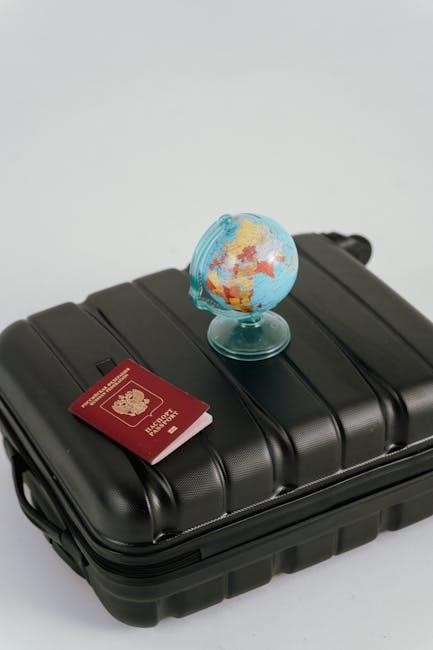A CDL pre-trip inspection is a critical process ensuring vehicle safety and compliance with FMCSA regulations. It involves a detailed checklist to identify potential issues before driving‚ promoting road safety and reducing risks of accidents or violations. This structured inspection is essential for all commercial drivers‚ helping them stay compliant and prepared for their journey.
Importance of Pre-Trip Inspections
Pre-trip inspections are essential for ensuring the safety and roadworthiness of commercial vehicles. They help identify potential mechanical issues before they lead to accidents or breakdowns‚ protecting both the driver and other road users. Conducting these inspections also ensures compliance with FMCSA regulations‚ avoiding costly fines and violations. A thorough pre-trip inspection promotes a culture of safety‚ reduces the risk of mechanical failures‚ and minimizes downtime. Additionally‚ it helps drivers develop a routine that prepares them mentally for the journey ahead. By addressing issues early‚ pre-trip inspections contribute to smoother operations‚ lower maintenance costs‚ and enhanced overall efficiency.
Legal Requirements and FMCSA Guidelines
The Federal Motor Carrier Safety Administration (FMCSA) mandates that all commercial drivers perform pre-trip inspections to ensure vehicle safety and compliance. These inspections are legally required under FMCSA regulations‚ specifically Section 396.11‚ which outlines the procedures for inspecting vehicles. Drivers must check critical components such as brakes‚ tires‚ lights‚ and cargo securement. Failure to comply can result in fines‚ penalties‚ and even the placement of a vehicle out of service. Adhering to these guidelines not only avoids legal consequences but also contributes to public safety. The FMCSA provides detailed inspection criteria‚ and drivers are expected to follow them meticulously to maintain compliance and ensure safe operations on the road.

Engine Compartment Inspection
The engine compartment inspection involves checking oil and fluid levels‚ coolant‚ battery condition‚ belts‚ and hoses for signs of wear or leaks to ensure proper engine function.
Oil and Fluid Levels
Checking oil and fluid levels is a critical step in the engine compartment inspection. Ensure the engine oil level is within the recommended range using the dipstick. Inspect coolant levels in the reservoir‚ verifying it’s properly mixed and within the minimum mark. Transmission fluid‚ brake fluid‚ and power steering fluid levels should also be checked for adequacy; Look for any signs of leaks around the reservoirs or hoses. Additionally‚ verify the windshield washer fluid level to ensure visibility during driving. Proper fluid levels are essential for maintaining engine performance‚ preventing overheating‚ and ensuring safe operation of the vehicle. Always refer to the manufacturer’s guidelines for specific fluid level requirements and top off as needed before starting the trip.
Coolant and Battery Check
The coolant and battery check is a vital part of the engine compartment inspection. Start by inspecting the coolant level in the reservoir‚ ensuring it meets the minimum mark and is properly mixed with water. Look for signs of leaks or discoloration‚ which could indicate contamination or damage. Next‚ examine the battery terminals for cleanliness and security‚ ensuring they are tightly connected and free of corrosion. Check the battery water levels if applicable and test the battery charge to ensure it holds power. Proper coolant and battery function are essential for engine performance and preventing overheating or electrical failures. Always refer to the manufacturer’s guidelines for specific recommendations and address any issues before starting the trip to avoid breakdowns.
Belt and Hose Inspection
The belt and hose inspection is a critical step in the engine compartment check. Start by visually inspecting all belts‚ such as the serpentine belt‚ for cracks‚ frays‚ or signs of wear. Ensure they are properly tensioned and not loose‚ as this can lead to engine failure. For hoses‚ check for leaks‚ soft spots‚ or bulges‚ which may indicate deterioration. Inspect the coolant hoses for proper connection to the radiator and engine. Use a tool to test belt tension and ensure it meets manufacturer specifications. Replace any damaged or worn belts and hoses immediately to prevent breakdowns. Neglecting this step can result in costly repairs or even safety hazards during operation.

Axle and Brake Inspection
The axle and brake inspection ensures vehicle safety and compliance with FMCSA regulations. Check brake components‚ including pads‚ drums‚ and chambers‚ for wear or damage. Perform a low air pressure test to verify brake functionality. Inspect axle alignment‚ lubrication‚ and suspension for proper operation. This step is crucial for maintaining control and preventing accidents during transit.
Brake Components Check
The brake components check is a critical part of the pre-trip inspection. Inspect brake pads‚ drums‚ and shoes for wear or damage. Ensure brake chambers are secure and functioning properly. Check the brake pedal for proper resistance and ensure it returns to its resting position. Examine the air brake system‚ including the compressor‚ air tanks‚ and valves‚ for leaks or damage. Test the low air pressure warning system to confirm it activates correctly. Verify that all brake lines and hoses are free from damage or leaks. This thorough inspection ensures the braking system is reliable and safe‚ preventing potential failures on the road. Always follow FMCSA guidelines and use a checklist to stay organized and compliant;
Low Air Pressure Test
The low air pressure test is a vital step in the pre-trip inspection‚ ensuring the air brake system functions correctly. Start by turning off the engine and pressing the brake pedal to release air pressure. Listen for any leaks and observe the air pressure gauge to ensure it drops to the correct level. If the pressure falls too quickly or the warning buzzer activates‚ there may be a system issue. This test verifies that the air brake system can maintain safe operating pressure‚ essential for reliable braking. Always follow FMCSA guidelines and refer to your vehicle’s manual for specific procedures. A failed low air pressure test indicates a potential safety hazard that must be addressed before driving.

Tires and Wheels Inspection
A thorough inspection of tires and wheels is essential for safety. Check tire condition‚ tread depth‚ and pressure‚ ensuring no signs of wear or damage. Inspect wheels and rims for cracks or looseness‚ and verify proper lug nut tightness. This step ensures vehicle stability and prevents potential blowouts or wheel-related hazards on the road.
Tire Condition and Tread Depth
Inspecting tire condition and tread depth is crucial for safety and compliance. Check for signs of wear‚ such as uneven tread‚ cracks‚ or bulges. Measure tread depth using a gauge; federal regulations require at least 1/16 of an inch for steer tires and 2/32 for others. Use the penny test as a quick reference: insert a penny into the tread groove with Lincoln’s head down; if his hair is visible‚ tread is worn below the legal limit. Proper tread ensures traction‚ reducing the risk of skidding or hydroplaning. Additionally‚ look for foreign objects lodged in tires and ensure valve caps are secure. Neglecting tire condition can lead to blowouts‚ accidents‚ or FMCSA violations‚ making this step vital for pre-trip safety checks.
Tire Pressure Check
Checking tire pressure is a critical step in the pre-trip inspection. Proper inflation ensures optimal vehicle handling‚ fuel efficiency‚ and safety. Always measure pressure when tires are cold‚ as driving can heat them up and give inaccurate readings. Use a reliable tire pressure gauge and compare the pressure to the manufacturer’s recommended levels‚ found on the tire information placard or in the vehicle’s manual. Under-inflation can lead to uneven wear‚ reduced traction‚ and increased risk of blowouts‚ while over-inflation can compromise braking performance. Ensure all tires‚ including the spare‚ meet the specified pressure. This step is essential for compliance with FMCSA regulations and for maintaining control of the vehicle on the road. Accurate tire pressure checks are vital for safe and efficient operation.
Wheel and Rim Inspection
The wheel and rim inspection is a vital part of the pre-trip process‚ ensuring the vehicle’s structural integrity and safety. Check for any visible damage‚ rust‚ or corrosion on the wheels and rims‚ as these can weaken their integrity. Verify that all lug nuts are securely tightened in a star pattern to maintain even pressure. Look for signs of wear or damage on the wheel studs and ensure the hubcaps are properly secured. Also‚ inspect the rims for dents or bends that could affect tire seating. Properly maintained wheels and rims are essential for safe operation and preventing potential failures on the road. This step ensures compliance with FMCSA standards and helps avoid costly repairs or safety hazards.

Lights and Electrical Systems
Inspect all exterior lights‚ including headlights‚ brake lights‚ and turn signals‚ to ensure proper function and visibility. Check electrical connections for damage or corrosion‚ ensuring all systems operate safely and efficiently.
Exterior Light Check
The exterior light check is a vital part of the CDL pre-trip inspection‚ ensuring all lights function properly for safety and visibility. Inspect headlights‚ brake lights‚ turn signals‚ and marker lights to confirm they are clean‚ undamaged‚ and operating correctly. Check for any cracks‚ broken lenses‚ or malfunctioning bulbs that could impair visibility or communication with other drivers. Additionally‚ verify that all lights are securely mounted and free from obstructions. Properly functioning lights are essential for complying with FMCSA regulations and avoiding potential safety hazards on the road. This step ensures your vehicle is visible to others‚ reducing the risk of accidents and legal issues.
Signal and Brake Light Test
The signal and brake light test ensures all lighting systems function correctly‚ crucial for safe communication with other road users. Begin by turning on the vehicle’s parking brakes and engaging the hazard lights to check for proper operation. Test the brake lights by pressing the brake pedal‚ ensuring they illuminate evenly and brightly. Check turn signals (both front and rear) by activating the left and right turn indicators. Use a helper or reflective surfaces to verify all lights are visible and functioning. This step ensures compliance with FMCSA regulations and enhances road safety. Properly functioning brake and signal lights are essential for clear communication and avoiding potential accidents or legal issues during operation.

Trailer Inspection
A trailer inspection involves checking the coupling‚ tires‚ brakes‚ and cargo securement to ensure safe operation and compliance with FMCSA regulations‚ preventing potential hazards on the road.
Coupling and Hitch Check
The coupling and hitch check ensures the trailer is securely attached to the tractor. Inspect the fifth wheel‚ kingpin‚ and locking jaws for proper engagement. Verify the kingpin is fully seated and the fifth wheel jaws are closed and locked. Check the hitch for any signs of damage‚ wear‚ or corrosion. Ensure the trailer is properly aligned with the tractor to prevent shifting during transit. For pintle hooks or other coupling types‚ confirm they are securely fastened and free from damage. This step is critical to maintain trailer stability and prevent detachment while driving‚ ensuring safety and compliance with FMCSA regulations.
Trailer Tire and Brake Inspection
The trailer tire and brake inspection ensures the trailer’s tires and braking system are safe and functional. Check tire condition for wear‚ cuts‚ or bulges‚ and measure tread depth using a gauge. Ensure tires are properly inflated according to the manufacturer’s specifications. Inspect the brake components‚ including brake pads‚ drums‚ and shoes‚ for wear or damage. Verify the slack adjusters are properly adjusted and the brake chambers are functioning correctly. Perform a low air pressure test to ensure the braking system engages when air pressure drops. This step is crucial for maintaining control and preventing accidents‚ ensuring compliance with FMCSA safety standards and promoting safe operation of the vehicle.
Cargo Securement
Cargo securement is a critical step in the pre-trip inspection to ensure safety and compliance with FMCSA regulations. Drivers must verify that all cargo is properly tied down using approved tie-downs‚ straps‚ or chains. Check that the cargo is evenly distributed and balanced to prevent shifting during transit. Ensure all securing devices are in good condition‚ free from damage or wear. Additionally‚ verify that the cargo does not obstruct the driver’s view or interfere with vehicle controls. Proper cargo securement prevents accidents caused by shifting loads and ensures compliance with federal safety standards. Always refer to the FMCSA guidelines for specific cargo securement requirements based on the type of load being transported.

Driver Vehicle Inspection Report (DVIR)
The DVIR is a legal document required by the FMCSA‚ ensuring drivers document all vehicle inspection findings. It promotes safety‚ accountability‚ and compliance by detailing defects and necessary repairs.
Purpose of DVIR
The primary purpose of the Driver Vehicle Inspection Report (DVIR) is to ensure the safety and roadworthiness of commercial vehicles. It serves as a legal document that records the condition of the vehicle before and after each trip‚ helping to identify and address potential mechanical issues early. By documenting inspection findings‚ drivers and fleet operators can maintain compliance with FMCSA regulations‚ reduce the risk of accidents‚ and prevent costly repairs. The DVIR also provides a clear communication channel between drivers and maintenance personnel‚ ensuring that all necessary repairs are made promptly. This systematic approach to vehicle inspection is vital for upholding safety standards and operational efficiency in the trucking industry.
Documenting Inspection Findings
Accurate and detailed documentation of inspection findings is crucial for maintaining compliance and ensuring vehicle safety. The DVIR must include specific details about any defects or issues identified during the pre-trip inspection‚ such as faulty brakes‚ worn tires‚ or malfunctioning lights. Drivers are required to list all defects and certify that the vehicle is safe to operate. If issues are found‚ they must be reported to the carrier or maintenance team for prompt resolution. Failure to document inspection findings correctly can result in legal penalties and safety risks. Proper documentation also provides a clear record of the vehicle’s condition‚ helping to avoid disputes and ensuring accountability. By maintaining thorough and accurate records‚ drivers and fleets can demonstrate their commitment to safety and regulatory compliance. This step is essential for passing CDL exams and operating responsibly on the road.

Memory Aid for Pre-Trip Inspection
Memory aids like the Association Technique and Memory Palace Method help drivers recall inspection steps. Break down sections‚ create mental associations‚ and visualize inspection points in a familiar space to ensure completeness and accuracy during the pre-trip process.
Association Technique
The Association Technique is a powerful memory aid for mastering the CDL pre-trip inspection. By breaking down the inspection into smaller‚ manageable sections‚ drivers can link each step to a personal memory or object. For example‚ associating engine checks with a mental image of the truck’s front or connecting tire inspections with a familiar landmark. This method helps create vivid mental connections‚ making it easier to recall each inspection point. Drivers can also visualize the truck’s components in a specific order‚ ensuring no critical areas are overlooked. Over time‚ this technique becomes second nature‚ streamlining the inspection process and improving efficiency. It’s a proven strategy to stay organized and thorough during pre-trip checks.
Memory Palace Method
The Memory Palace Method is a highly effective technique for remembering the CDL pre-trip inspection steps. By visualizing a familiar place‚ such as your home‚ and associating each inspection step with a specific location within that space‚ you can create a mental map. For example‚ link checking the engine compartment to the front door or tire inspections to the living room. As you mentally walk through your “palace‚” each area triggers the memory of a corresponding inspection task. This method helps organize and retain information‚ ensuring no steps are missed; Over time‚ the process becomes automatic‚ making pre-trip inspections faster and more efficient. It’s a valuable tool for drivers preparing for their CDL exam or maintaining consistent inspection routines.

Common Mistakes to Avoid
Overlooking critical inspection points‚ such as brake components or tire tread depth‚ and incorrect documentation practices are common errors. Ensure thorough checks and accurate reporting to avoid violations.
Overlooking Critical Inspection Points
One of the most frequent mistakes during a CDL pre-trip inspection is failing to thoroughly check essential components. Many drivers overlook critical areas such as brake components‚ tire tread depth‚ and fluid levels‚ which can lead to safety hazards and legal violations. For instance‚ neglecting to inspect brake pads or air pressure can result in brake failure‚ while ignoring tire tread depth may cause blowouts. Similarly‚ skipping the coolant or oil levels can lead to engine damage. These oversights often occur due to rushing or lack of attention to detail. To avoid such errors‚ drivers should follow a structured checklist and allocate sufficient time for the inspection process. Consistency and thoroughness are key to ensuring roadworthiness and compliance with FMCSA regulations.
Incorrect Documentation Practices
Incorrect documentation practices during a CDL pre-trip inspection can lead to serious consequences‚ including fines and compliance issues. Many drivers fail to accurately record inspection findings‚ omitting critical details or providing vague descriptions. For instance‚ not specifying the severity of a defect or neglecting to note repairs can result in non-compliance with FMCSA regulations. Additionally‚ incomplete or illegible documentation‚ such as unreadable handwriting or missing signatures‚ can render the DVIR invalid. Drivers must ensure all findings are clearly documented‚ using standardized terminology and adhering to federal guidelines. Proper documentation not only ensures accountability but also helps maintain a safe operating environment. Consistent and accurate record-keeping is essential for avoiding legal repercussions and promoting overall fleet safety.

Practice Test and Exam Preparation
A comprehensive CDL pre-trip inspection study guide includes practice tests and exam strategies. Mastering sample questions and understanding the inspection process ensures confidence and success during the actual test.
Sample Pre-Trip Inspection Questions
Sample questions for the CDL pre-trip inspection include: What steps should be taken to check engine oil levels? How do you properly inspect tire tread depth? What are the signs of worn brake pads? How do you test low air pressure in the brake system? What is the correct procedure for checking exterior lights? How do you ensure cargo is properly secured? These questions cover critical areas of the inspection process‚ helping drivers prepare for the exam and understand key safety checks. Practicing with these questions ensures a thorough understanding of the inspection steps and compliance with FMCSA guidelines.
Test-Taking Strategies
To excel in the CDL pre-trip inspection test‚ employ effective strategies. First‚ thoroughly review the inspection checklist and practice regularly. Understand the exam format and focus on key areas like brakes‚ tires‚ and lights. Time management is crucial—allocate equal attention to each section. Stay calm and read questions carefully to avoid mistakes. Practice with sample questions to build confidence and identify weak areas. Reviewing the Driver Vehicle Inspection Report (DVIR) process is also essential. Familiarize yourself with the memory aid techniques‚ such as the association method‚ to remember inspection steps. Lastly‚ ensure you understand the examiner’s expectations and demonstrate a systematic approach during the test. These strategies will help you perform efficiently and pass with confidence.
Mastery of the CDL pre-trip inspection ensures safe‚ compliant‚ and efficient driving. A structured approach builds confidence‚ preventing accidents and violations‚ while promoting professionalism and accountability on the road.
A thorough CDL pre-trip inspection covers critical areas to ensure safety and compliance. Start with the engine compartment‚ checking oil‚ coolant‚ and battery levels‚ as well as belts and hoses. Inspect axles and brakes‚ performing a low air pressure test for proper function. Tires and wheels must be examined for tread depth‚ pressure‚ and damage. Lights and electrical systems require testing of exterior‚ signal‚ and brake lights. Trailer inspections include coupling‚ hitch‚ tire‚ and brake checks‚ along with cargo securement. Documenting findings in a DVIR is essential for legal compliance. Each section has specific steps to follow‚ ensuring no critical points are overlooked. Missing these can lead to safety risks or violations‚ making a detailed checklist indispensable for drivers.
Final Tips for a Successful Inspection
To ensure a successful CDL pre-trip inspection‚ always use a comprehensive checklist to stay organized and avoid missing critical points. Practice the inspection process regularly to build confidence and muscle memory. Utilize memory aids like the association technique or memory palace method to remember key steps. Review your findings and document them accurately in the DVIR to maintain compliance. Stay updated on FMCSA regulations and adapt to any changes in inspection requirements. Conduct inspections systematically‚ starting from the engine compartment and moving through each section methodically. Avoid rushing‚ as thoroughness is key to safety and compliance. By following these tips‚ you’ll master the pre-trip inspection process‚ ensuring a safe and efficient journey every time.
